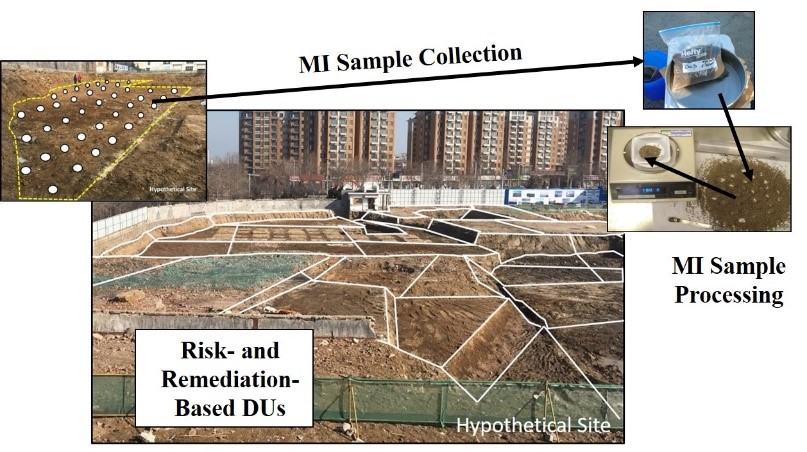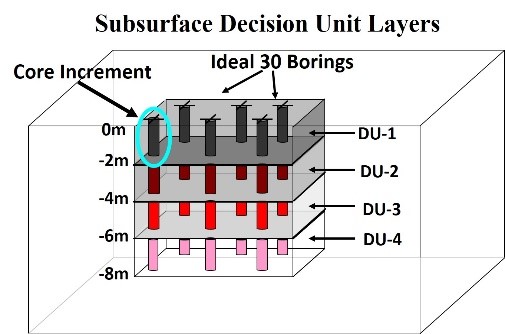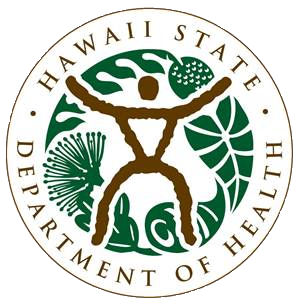Decision Unit and Multi Increment Sampling Methods
DU-MIS Investigation Methods
“Decision Unit” and “Multi Increment®” sample investigation methods (DU-MIS) for soil, sediment and related particulate material, represent a significant advancement from the past use of “discrete” sampling methods in environmental investigations. (Multi Increment® is a registered trademark of Envirostat). Decision Units are designated based on the assessment of risk or optimization of anticipated, remedial actions. Multi Increment sampling methods ensure that the data collected are representative of targeted area and volume of material and directly address the investigation questions being asked.”
Research on DU-MIS investigation methods was initiated by John Peard of the HEER Office in 2004. DU-MIS investigation methods are based on decades of research and statistical analysis of sample data by the mining industry for testing of crushed ore and other particulate matter. Unlike the environmental industry, the reliability and accuracy of sample data are ultimately tested in the mining industry by comparison of the mass of the commodity extracted from a targeted volume of crushed ore to the mass initially predicted by sample data.
The unreliability of discrete sample data, including use of a 95% UCL to estimate a mean concentration from a single set of data, was explicitly realized and led to the development of Gy’s Theory of Sampling. The lack of a comparable measure of data accuracy, aside from the common failure of in situ remedial actions due to underestimations of total contaminant mass, in part explains the long delay in the transition from discrete sampling methods to more reliable, DU-MIS methods in the environmental industry.
The lack of a comparable measure of data accuracy, aside from the common failure of in situ remedial actions due to underestimations of total contaminant mass, in part explains the long delay in the transition from discrete sampling methods to more reliable, DU-MIS methods in the environmental industry.
The HIDOH DU-MIS guidance represents a direct application of Gy’s Theory of Sampling to the investigation of contaminated soil and sediment in the environmental industry. Initial guidance was published in 2009 in the HEER Office Technical Guidance Manual (TGM). The guidance was updated in 2016. Additional updates are pending. Check the TGM webpage to ensure that you have the latest edition.

Key sections the TGM on the background and implementation of DU-MIS investigation methods include:
- Section 3: Systematic Planning and DU Designation;
- Section 4: DU Characterization and MI Sample Collection, Processing and Analysis;
- Section 5: Field Implementation of DU-MIS Investigation Methods
Section 3 describes a nine-step process for design and implementation of an environmental investigation and provides examples of DU designation under different site scenarios. Section 4 discusses the inherent error and limitations of past, discrete sampling methods and describes the collection, processing and analysis of Multi Increment samples. Section 5 discusses methods to prepare sites for testing, demarking of DUs in the field and example tools for the collection of soil and sediment samples under different field conditions.
This includes the collection of subsurface samples as well as samples to be tested for volatile and semi-volatile chemicals. Section 8 of the TGM includes guidance on the use of field screening methods, including a portable XRF, to assist in DU designation and rapid identification of contaminated areas and volumes of soil.
 |
 |
Requirement for DU-MIS Data in Other HIDOH Programs
 Adherence to the HEER Office TGM is also required for investigations carried out under the oversight of the HIDOH Solid and Hazard Waste Branch (SHWB). Click here for the SHWB policy (Sept 2019). DU-MIS data is required for disposal of soil at municipal landfills in the state, for example PVT landfill on O′ahu. The HIDOH Clean Water Branch requires use of DU-MIS investigation methods is also required for testing of dredged sediment to be used as fill material in upland areas, which is also overseen by the SHWB.
Adherence to the HEER Office TGM is also required for investigations carried out under the oversight of the HIDOH Solid and Hazard Waste Branch (SHWB). Click here for the SHWB policy (Sept 2019). DU-MIS data is required for disposal of soil at municipal landfills in the state, for example PVT landfill on O′ahu. The HIDOH Clean Water Branch requires use of DU-MIS investigation methods is also required for testing of dredged sediment to be used as fill material in upland areas, which is also overseen by the SHWB.
Use the DU-MIS investigation methods presented in the HEER Office TGM for environmental reports, including the term “Multi Increment.” Do not assume that DU-MIS investigation methods presented in the HEER Office TGM are identical to similar guidance published elsewhere. The use of other terms to describe soil and sediment samples will call into question the familiarity of the authors with HEER Office DU-MIS guidance and could delay approval of workplans and environmental investigation reports.
Field Research
Discrete Sample Data Reliability
 HEER Office staff carried out a detailed investigation of discrete sample data variability and reliability in 2015 and 2016, using funding provided by the USEPA. Links to the investigation report, recorded presentations on the study and a published, two-part paper on the results of the study can be found on the HEER Office research webpage. Links to recorded presentations can be found on the HEER Office webinar webpage.
HEER Office staff carried out a detailed investigation of discrete sample data variability and reliability in 2015 and 2016, using funding provided by the USEPA. Links to the investigation report, recorded presentations on the study and a published, two-part paper on the results of the study can be found on the HEER Office research webpage. Links to recorded presentations can be found on the HEER Office webinar webpage.
Reliability of Sub-slab Vapor Data
 Similar problems with the reliability of small-volume, discrete sample data also apply to soil vapor samples. HEER Office staff carried out an investigation of the reliability of sub-slab vapor sample data in 2017 using funding provided by the USEPA. The result was the development of Large Volume Purge methods for assessment of vapor intrusion risk posed by sub-slab vapor plumes. Guidance on the use of “LVP” sampling methods is provided in Section 7 of the TGM. Links to recorded presentations can be found on the HEER Office webinar webpage.
Similar problems with the reliability of small-volume, discrete sample data also apply to soil vapor samples. HEER Office staff carried out an investigation of the reliability of sub-slab vapor sample data in 2017 using funding provided by the USEPA. The result was the development of Large Volume Purge methods for assessment of vapor intrusion risk posed by sub-slab vapor plumes. Guidance on the use of “LVP” sampling methods is provided in Section 7 of the TGM. Links to recorded presentations can be found on the HEER Office webinar webpage.
HEER staff teamed up with private industry experts to publish a paper (Brewer et al 2014) that highlighted the limitations of small-volume, “discrete” soil vapor sample data and why a transition to large-volume, LVP-type sampling methods is necessary. Included is a discussion of the hidden but inherent errors in USEPA’s vapor intrusion “empirical database” and why indoor air:subslab attenuation factors (SSAFs) presented in the affiliated guidance document are unreliable. The 2014 paper presents alternative SSAFs based on databases and models used to study building leakage in the building ventilation and energy efficiency industries. Related research by the HEER Office highlights the importance of TPH over traditional BTEX data in vapor intrusion risks associated with petroleum contaminated soil and groundwater (Brewer et al. 2013). Links to the field investigation report and recorded presentations on the study can be found on the HEER Office research webpage and the HEER Office webinar webpage.
Use of Discrete Sample Data
 Adherence to DU-MIS investigations methods as described in the HEER Office TGM is required for final decision making at all environmental investigations of soil, sediment and related, particulate material carried out in Hawai′i. As described in Section 4, existing discrete sample data can in some cases be useful to help design a DU-MIS investigation. The use of discrete sample data for final decision making is not, however, permitted. This includes the use of discrete sample data for estimate of contaminant means and use in risk assessments. As described in the below letters to NAVFAC Pacific and USEPA Region 9, this includes the investigation of sites overseen by the Department of Defense:
Adherence to DU-MIS investigations methods as described in the HEER Office TGM is required for final decision making at all environmental investigations of soil, sediment and related, particulate material carried out in Hawai′i. As described in Section 4, existing discrete sample data can in some cases be useful to help design a DU-MIS investigation. The use of discrete sample data for final decision making is not, however, permitted. This includes the use of discrete sample data for estimate of contaminant means and use in risk assessments. As described in the below letters to NAVFAC Pacific and USEPA Region 9, this includes the investigation of sites overseen by the Department of Defense:
- Use of Discrete vs DU-MIS data DoD Sites (USEPA 2019)
- Response to US Navy Regarding Use of Discrete vs DU-MIS Data
Training and Presentations
A six-part training series on the background and use of DU-MIS investigation methods and the use of DU-MIS data in Environmental Hazard Evaluations is posted to the HEER Office YouTube webpage.
Part 1: Systematic Planning and Site Investigation
Part 2: Decision Unit Designation
Part 3: Sampling Theory and Discrete vs Multi Increment Sampling Methods
Part 4: Field Implementation of DU-MIS Methods
Part 5: Laboratory Processing
Part 6: Environmental Hazard Evaluation
Links to additional presentations on DU-MIS investigation methods are posted to the HEER Office webinar webpage.
Additional Training
Francis Pitard (Francis Pitard Sampling Consultants, LLC)
 Francis Pitard is recognized as the world’s leading expert on the statistical basis and application of Pierre Gy’s Theory of Sampling. Although focused on testing of commodities in crushed ore in the mining industry, the theory and sampling methods introduced are also directly applicable to testing of contaminants in soil, sediment and similar particulate matter.
Francis Pitard is recognized as the world’s leading expert on the statistical basis and application of Pierre Gy’s Theory of Sampling. Although focused on testing of commodities in crushed ore in the mining industry, the theory and sampling methods introduced are also directly applicable to testing of contaminants in soil, sediment and similar particulate matter.
Chuck Ramsey ( EnviroStat)
 Chuck Ramsey, formerly with the USEPA, is an internationally recognized sampling expert with significant experience in the environmental industry. Mr. Ramsey has been instrumental in the continuing development of Hawaii’s DU-MIS investigation guidance since 2004. Regulators and consultants working in Hawaii are encouraged to take Ramsey’s four-day, introductory class Sampling for Defensible Environmental Decisions. The class covers the basics of Gy’s Theory of Sampling as applied to environmental investigations and implementation of DU-MIS sampling methods in the field. The class also reviews the inherent error and limitations of “discrete” sample investigation methodologies.
Chuck Ramsey, formerly with the USEPA, is an internationally recognized sampling expert with significant experience in the environmental industry. Mr. Ramsey has been instrumental in the continuing development of Hawaii’s DU-MIS investigation guidance since 2004. Regulators and consultants working in Hawaii are encouraged to take Ramsey’s four-day, introductory class Sampling for Defensible Environmental Decisions. The class covers the basics of Gy’s Theory of Sampling as applied to environmental investigations and implementation of DU-MIS sampling methods in the field. The class also reviews the inherent error and limitations of “discrete” sample investigation methodologies.
Related Material
10th World Conference on Sampling and Blending (June 2022)
The paper entitled “Fake Data? The Need for Theory of Sampling Concepts in Environmental Research and Investigations” was presented and published by Roger Brewer (HIDOH), Chuck Ramsey (Envirostat), Marvin Heskett (Element Environmental) and Jing Song (Chinese Academy of Sciences) as part of an international sampling conference held in Kristiansand, Norway, in May-June 2022. The conference was attended by a wide range of sampling experts from the mining, agricultural, pharmaceutical, recycling and environmental industries. The paper discusses widely used but highly unreliable and inefficient sampling methods typical of the environmental industry and the need to transition to more science-based and reliable methods long used by the commodities industry.
ITRC ISM Update (Nov 2020)
In 2020, the Interstate Technical and Regulatory Council (ITRC) published an update to the organization’s 2012 Incremental Sampling Methodology (IS) guidance document of the same title. A critique of the updated document is provided below.
Links to PowerPoint slides, the HIDOH Critique of 2020 ITRC ISM Update PDF document, and a recorded presentation on the critique originally given to the USEPA ISM Sampling Committee is posted to the HEER Office webinar webpage.
ISM-type investigation methods are similar in concept to the Hawai′i DU-MIS, guidance. HEER Office staff and Hawaii-based consultants assisted in the initial preparation of the ITRC documents but were not part of the final work groups. While less detailed than the Hawai′i guidance, discussions of the nature of contaminants in soil and the implementation of “ISM” methods in the field and at the laboratory in the 2020 update are much improved and, with the caveats noted in the HIDOH critique, will be useful for those just getting started in these types of sampling strategies.
In sharp contrast, discussions of “statistical concepts,” ISM data quality evaluation and the use of ISM-type data in risk assessments, prepared by a separate section of the update team, do not express a strong understanding of Gy’s Theory of Sampling and include numerous omissions, misleading statements and outright errors. Concise and critical discussions of the statistical underpinnings of ISM-type sampling methods and decades of field research by the mining industry are shockingly missing from the sections. The authors instead mistakenly attempt to discuss the nature of ISM-type sampling methods in terms of classic, “inferential” statistics utilized in the past to interpret discrete sample data – the same methods that Gy’s Theory of Sampling demonstrated to be unreliable and not applicable to testing of complex, particulate matter such as soil and sediment.
Of particular concern is the erroneous, implied requirement to collect replicate ISM samples in every DU (at significant added cost and effort) and utilize a 95% UCL for comparison to screening levels and assessment of risk. This has no basis in Gy’s Theory of Sampling and could unfortunately be seen as a “poison pill” for use of ISM-type sampling methods and the necessary transition away from less reliable, discrete sampling methods.
Readers are advised to overlook these sections of the otherwise useful ITRC ISM update and defer to references and guidance prepared by sampling statisticians with a more in-depth understanding of Gy’s Theory of Sampling. Updated methods for evaluation of ISM-type data more consistent with Gy’s Theory of Sampling are included as an appendix to the HIDOH critique. The noted approaches will be included in updates to the Hawaii DU-MIS investigation guidance, anticipated in early 2021, posted below.
DU-MIS in China
Webinars – Chinese subtitles have been added to the six-part, 2017 DU-MIS and ESL training series posted to the HEER Office webinar webpage. Look for the link “Chinese Subtitles” at the end of the training posting.
Guidance – Roger Brewer of the HEER Office worked with Dr. Song Jing of the Institute of Soil Science, Chinese Academy of Sciences (CAS) to translate the Hawai’i DU-MIS guidance into Chinese and expand the document for use in China. An English adaptation of the CAS guidance is available for review and comment at the below links.
Environmental Characterization and Assessment of Contaminated Soil and Sediment (Brewer and Song, draft May 2022)
This document is an expanded, English adaption of a National Standard prepared by the Chinese Academy of Sciences and titled Soil Quality Decision Unit-Multi Increment Sampling (国家标准, 土壤质量 决策单元-多点增量采样法; CAS 2022). Preparation of both versions of the guidance was jointly overseen by the authors noted below. In both cases the documents reflect a rearrangement and expansion of sampling guidance presented in the Hawai′i Department of Health Technical Guidance Manual for investigation of environmental contamination (HIDOH 2021). The guidance represents the collective experience of a large group of international environmental experts trained in Gy’s Theory of Sampling. Although primarily focused on the characterization of contaminated soil, the methods introduced are also applicable to the investigation of contaminated sediment and other particulate media.
The guidance is presented in two parts. Part 1 provides a basic but concise overview of the site investigation process, beginning with Systematic Planning and the designation of risk- or remediation-based Decision Units (DUs) for characterization and ending with the collection and evaluation of Multi Increment® Sample (MIS) data (“Multi Increment” is a registered trademark of EnviroStat, Inc.). Part 2 of the guidance presents a series of appendices that provide detailed discussions and examples of each aspect of the site investigation process as well as references for additional information. A fact sheet overview of DU-MIS investigation methods is provided in Appendix A.
The expanded English version of the Chinese National Standard includes additional sections and information due to more strict formatting and length restraints for the latter. Final review of both the English and Chinese versions of the document underway as of May 2022. Comments and suggestions for the English version are welcome and should be submitted to Roger Brewer at the below email address. Formal publication of both documents is anticipated in the summer of 2022.
Reference: Brewer, R. and J. Song, 2022, Environmental Characterization and Assessment of Contaminated Soil and Sediment, May 2022 (draft).
Authors:
| Roger Brewer, PhD Environmental Health Administration Hawaii Department of Health Honolulu, Hawaii USA Email: [email protected] | Jing Song, PhD Institute of Soil Science Chinese Academy of Sciences Nanjing, China Email: [email protected] |
Additional Information: Contact Sven Lindstrom of the HEER Office ([email protected]) for questions, comments and suggestions for edits and future updates of the Hawaiʻi DU-MIS guidance.

